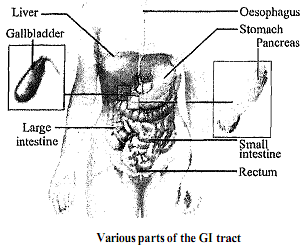Q. Show Gastrointestinal Diseases and Disorders?
Before discussing the many gastrointestinal problems, it is useful to understand the basic physiology of the gastrointestinal tract. Figure illustrates the different parts of the gastrointestinal tract. You would recall from your Applied Physiology Course ($EN-001),

The gastrointestinal system performs the following four important functions. It helps to:
- Store food,
- mix the food with enzymes produced in different parts of the gastrointestinal tract to break the complex foods to simpler forms of food (digestion),
- propel the food mixture through mouth, oesophagus, stomach, duodenum, small and large intestines to the anus, and
- absorb the various nutrients into the blood especially from small intestine and outer parts.
Looking at the functions, you can understand that any disorder or diseases of a particular part can affect the storage, propulsion, digestion and result in nutrient deficiencies. We shall discuss the same in this unit and will begin with diarrhoea - one of the most common and fatal GI tract problems.